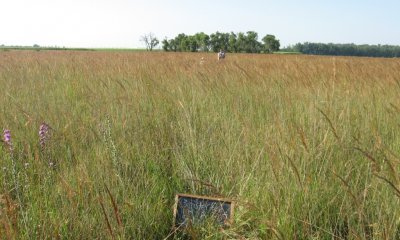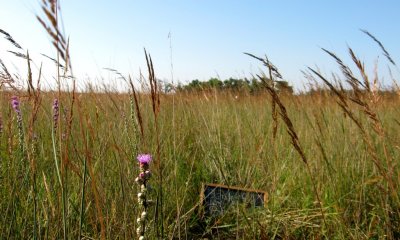
Subirrigated
Scenario model
Current ecosystem state
Select a state
Management practices/drivers
Select a transition or restoration pathway
- Transition T1 More details
- Transition T2 More details
- Transition T3 More details
- Restoration pathway R1 More details
- Transition T4 More details
- Restoration pathway R2 More details
-
No transition or restoration pathway between the selected states has been described
Target ecosystem state
Select a state
Description
This state represents the natural range of variability that dominated the dynamics of this ecological site. This state was diverse, stable, productive and well adapted to the Northern Great Plains. The high water table supplied much of the moisture for plant growth. Plant litter was properly distributed with little movement and natural plant mortality was very low. This was a sustainable state in terms of soil stability, watershed function and biologic integrity. This state was dominated by warm-season grasses, with lesser amounts of cool-season grasses and a wide variety of forbs. The primary disturbance mechanisms for this site in the reference condition included periodic fire and grazing by large herding ungulates. Timing of fires and grazing coupled with weather events dictated the dynamics that occurred within the natural range of variability. Mid and tall statured grass species could have declined with a corresponding increase in short statured warm-season grasses and cool-season grass-like species occurring. Periods of above normal precipitation would have shifted this plant community to one dominated by prairie cordgrass, northern reedgrass, switchgrass, sedges and spikerush.
Submodel
Description
This state is very similar to the reference state in appearance and function. The invasion of introduced species has altered the natural range of variability for this ecological site. This state still has a strong component of warm-season grass species, but invasive introduced cool-season sodgrasses are now present in all community phases of this state. The primary disturbance mechanisms for this state include grazing by domestic livestock and infrequent fires. Grazing coupled with weather events dictate the dynamics that occur within this state. Fire could still play an important role, but is typically suppressed or applied in a manner which does not mimic the historical disturbance regime (frequency and timing). The warm-season native grasses can decline and an increase in introduced sod grasses will occur.
Submodel
Description
Visually, this state is characterized by a dominance of shrubs and an understory of introduced cool-season sod forming grasses. Once established, this state is very stable and resistant to change
Submodel
Description
This state is the result of invasion and dominance by introduced species. This state is characterized by the dominance of primarily Kentucky bluegrass but may also include quackgrass, redtop, and other non-native forbs such as leafy spurge and Canada thistle. Other forbs present are western ragweed and goldenrods. Once this state is well established, even drastic events such as high intensity fires driven by high fuel loads of litter and thatch will not result in more than a very short term reduction of Kentucky bluegrass.
Submodel
Mechanism
Transition from Reference State (State 1) to Native/Invaded State (State 2)
This was the transition from the native warm-season grass dominated reference state to a state that has been invaded by introduced species. When propagules of non-native species such as Kentucky bluegrass are present, this transition occurs as natural and/or management actions favored a decline in the composition of warm-season rhizomatous grasses and an increase in cool-season sodgrasses. This transition was compounded by a change in the historic grazing and fire regime where native herbivores would follow periodic fires with grazing. This historic grazing/fire sequence has largely been replaced by season-long grazing. Complete rest from grazing and suppression of fire can also hasten this transition. The threshold between states was crossed when Kentucky bluegrass, smooth bromegrass, redtop and other introduced species became established on the site. These species occupy functional/structural groups that were not present in the Reference State.
Mechanism
Transition from Native/Invaded State (State 2) to the Shrub Dominated State (State 3)
The elimination of fire is the major contributor to this transition. The opportunity for high intensity spring burns is severely reduced by early green up, and increased moisture and humidity at the soil surface. Plant litter accumulation tends to favor the more shade tolerant introduced grass species such as Kentucky bluegrass and shrubs such as snowberry and willow. Studies indicate that soil biological activity is altered, and this shift apparently exploits the soil microclimate and encourages growth of the introduced grass species. Preliminary studies would tend to indicate the primary threshold may exist when Kentucky bluegrass exceeds 30% of the plant community and native grasses represent less than 40% of the plant community composition. A secondary threshold occurs when the extent of the shrub component begins to decrease herbaceous production, further reducing fire behavior. Once this threshold is crossed fire alone is no longer an effective tool for restoring the herbaceous portion of the plant community.
Mechanism
Transition from Native/Invaded State (State 2) to the Invaded State (State 4)
This transitional pathway is triggered by extended rest, heavy grazing without adequate recovery periods, or “go-back” after cropping. Preliminary studies would tend to indicate the primary threshold may exist when Kentucky bluegrass exceeds 30% of the plant community and native grasses represent less than 40% of the plant community composition.
Under heavy grazing, the very grazing tolerant introduced species have the competitive advantage. The opportunity for high intensity spring burns (which can serve to reduce the introduced cool-season species) is severely reduced by early green up and the lack of fuel. The nutrient cycle is impaired due to the lack of available carbon for soil biota due to accumulation in the surface layer root mat. This results in reduced soil biological activity. Studies indicate that soil biological activity is altered, and this shift apparently exploits the soil microclimate and encourages growth of the introduced grass species.
Extended periods of non-use can also initiate this transition. The accumulation of plant litter shifts the competitive advantage to the shade tolerant introduced species. The lack of sunlight reaching the crowns of the remnant warm season grasses puts them at a further competitive disadvantage. This “non-use” and “over-use” often occurs within close proximity to each other in properly stocked pastures with low animal densities.
Previously cropped areas which are not seeded to properly adapted species but allowed to “go-back” will also develop this plant community phase. Failed plantings, or plantings which are not properly managed with prescribed grazing and prescribed burning after establishment, will also follow this pathway.
Once the threshold is crossed, a change in grazing management alone cannot cause a reduction in sodgrass dominance. Preliminary studies would tend to indicate this threshold may exist when Kentucky bluegrass exceeds 30% of the plant community and native grasses represent less than 40% of the plant community composition.
Mechanism
Herbicide and mechanical brush control combined with proper seedbed preparation and range seeding may restore this plant community to something resembling the Native/Invaded State (State 2.0). Intensive management with prescribed grazing and fire will be required after seeding to prevent the re-establishment of introduced sod forming species.
Relevant conservation practices
| Practice | External resources |
|---|---|
|
Brush Management |
|
|
Prescribed Burning |
|
|
Prescribed Grazing |
|
|
Herbaceous Weed Control |
Mechanism
Transition from Shrub Dominated State (State 3) to the Invaded State (State 4)
This transition is initiated by the removal of shrubs species from plant community phase 3.1 by use of mechanical treatments, herbicide treatments, and prescribed fire. Due to the sprouting nature of the shrubs occupying this community phase, multi treatments may be necessary. The removal of the shrub component will result in a transitional shift to plant community phase 4.1.
Mechanism
This pathway requires intensive restoration practices including prescribed burning, multiple herbicide treatments for seedbed preparation, and range seeding with adapted species. Intensive management will be required after seeding to prevent the re-establishment of introduced sod forming species.
Relevant conservation practices
| Practice | External resources |
|---|---|
|
Brush Management |
|
|
Prescribed Burning |
|
|
Prescribed Grazing |
|
|
Herbaceous Weed Control |
Model keys
Briefcase
Add ecological sites and Major Land Resource Areas to your briefcase by clicking on the briefcase (![]() ) icon wherever it occurs. Drag and drop items to reorder. Cookies are used to store briefcase items between browsing sessions. Because of this, the number of items that can be added to your briefcase is limited, and briefcase items added on one device and browser cannot be accessed from another device or browser. Users who do not wish to place cookies on their devices should not use the briefcase tool. Briefcase cookies serve no other purpose than described here and are deleted whenever browsing history is cleared.
) icon wherever it occurs. Drag and drop items to reorder. Cookies are used to store briefcase items between browsing sessions. Because of this, the number of items that can be added to your briefcase is limited, and briefcase items added on one device and browser cannot be accessed from another device or browser. Users who do not wish to place cookies on their devices should not use the briefcase tool. Briefcase cookies serve no other purpose than described here and are deleted whenever browsing history is cleared.
Ecological sites
Major Land Resource Areas
The Ecosystem Dynamics Interpretive Tool is an information system framework developed by the USDA-ARS Jornada Experimental Range, USDA Natural Resources Conservation Service, and New Mexico State University.




